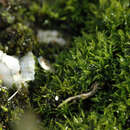Comments
(
Anglèis
)
fornì da eFloras
In the United States, all specimens named Tortella flavovirens that were collected inland from coastal habitats were redetermined to be some other species: most frequently T. humilis, Trichostomum crispulum, and Weissia species. The leaf cross section of Tortella flavovirens exhibits an adaxial layer of quadrate, papillose cells across its surface throughout the leaf length excepting the proximal region and the extreme apex. The peristome of Tortella flavovirens is somewhat short, but not rudimentary. It is erect or somewhat inclined and reminiscent of Trichostomum peristomes, which are smooth, papillose or striolate and generally erect. Sterile Weissia species may be confused with T. flavovirens, being pale yellow with the same cell size, and appearing to have a cucullate apex with the marginal basal cells somewhat extending up the leaf: these will, however, have no basal marginal extension on some leaves and the distal leaf margins will be tightly inrolled or incurved to a stronger degree than in any Tortella species; the substrate is frequently inappropriate in these specimens, such as bark at the base of trees or some other woody or humic substrate, likewise inland stations. Trichostomum crispulum, with which Tortella flavovirens has occasionally been confused, has smaller leaf cells, a broader, chestnut-colored costa and has a U-shaped proximal differentiated area of cells in all leaves. A. J. E. Smith (1978) recorded T. flavovirens var. glareicola (Christensen) Crundwell & Hyholm from Canada, most likely based on the citation by A. C. Crundwell and E. Nyholm (1962) of a depauperate specimen from Alberta (C. D. Bird 3624), identified by Bird as T. tortuosa. These plants “with longly tapering acutely pointed leaves” may be one of the peculiar instances of depauperate, large-celled T. tortuosa specimens (see discussion under that species). R. R. Ireland et al. (1987) considered var. glareicola to be absent from Canada, while L. E. Anderson et al. (1990) excluded it from North America.
- licensa
- cc-by-nc-sa-3.0
- drit d'autor
- Missouri Botanical Garden, 4344 Shaw Boulevard, St. Louis, MO, 63110 USA
Description
(
Anglèis
)
fornì da eFloras
Plants usually pale delicate yellow distally, yellow-brown proximally, elongate, not rosulate, annual whorls often evident. Stems 0.3-1 cm, hyalodermis large, sclero-dermis inconspicuous, cells of central cylinder thick-walled, central strand present, without tomentum, rhizoids thick and sparse at the base. Stem leaves loosely foliose, gradually somewhat larger and more crowded toward the stem tips, loosely to typically tightly incurled-contorted around the stem when dry, suberect to spreading when moist, oblong-ovate or ovate-lanceolate, strongly keeled-concave distally, medially flat to broadly channeled across the leaf proximally, 2-3.5 mm; base somewhat broader, elliptical; margins erect to incurved-involute, especially toward the apex, not or somewhat undulate, limb gradually or quickly narrowed; apex obtuse, subcucullate; costa percurrent or short-excurrent, rarely disappearing before the apex on some leaves, adaxial epidermal cells papillose-quadrate to short-rectangular at midleaf, frequently disappearing, showing smooth and narrowly elongate (6:1) stereid adaxial cells at the extreme apex; in cross section adaxial epidermis of quadrate, papillose cells typically present, occasionally absent in patches toward the apex, proximal laminal cells in larger leaves rather abruptly differentiated from distal cells, yellow-hyaline and nearly concolorous with the distal lamina, long-rectangular, 8(-9):1, laxly thin-walled, rather gradually papillose; distal laminal cells 10-12(-14) µm wide. Specialized asexual reproduction none. Sexual condition dioicous; perigonia not seen; perichaetial leaves little differentiated from stem leaves. Seta 1.1-1.3 cm. Capsule 1.8-2.2 mm, annulus none; operculum 0.75-1 mm, nearly subulate when young, more broadly long-conic just before dehiscence; peristome teeth relatively short, to 0.5 mm, straight or obliquely inclined and slightly twisted, especially when newly deoperculate.
- licensa
- cc-by-nc-sa-3.0
- drit d'autor
- Missouri Botanical Garden, 4344 Shaw Boulevard, St. Louis, MO, 63110 USA
Synonym
(
Anglèis
)
fornì da eFloras
Trichostomum flavovirens Bruch, Flora 12: 404, plate 2, fig. 7. 1829
- licensa
- cc-by-nc-sa-3.0
- drit d'autor
- Missouri Botanical Garden, 4344 Shaw Boulevard, St. Louis, MO, 63110 USA
Kędzierzawka żółtozielona: Brief Summary
(
polonèis
)
fornì da wikipedia POL
Kędzierzawka żółtozielona (Tortella flavovirens (Bruch) Broth.) – gatunek mchu należący do rodziny płoniwowatych (Pottiaceae Schimp.). Występuje w Ameryce Północnej, Europie, Azji (Syria), północnej Afryce, Makaronezji i Nowej Zelandii.
- licensa
- cc-by-sa-3.0
- drit d'autor
- Autorzy i redaktorzy Wikipedii
Tortella flavovirens: Brief Summary
(
vietnamèis
)
fornì da wikipedia VI
Tortella flavovirens là một loài Rêu trong họ Pottiaceae. Loài này được (Bruch) Broth. miêu tả khoa học đầu tiên năm 1902.
- licensa
- cc-by-sa-3.0
- drit d'autor
- Wikipedia tác giả và biên tập viên

